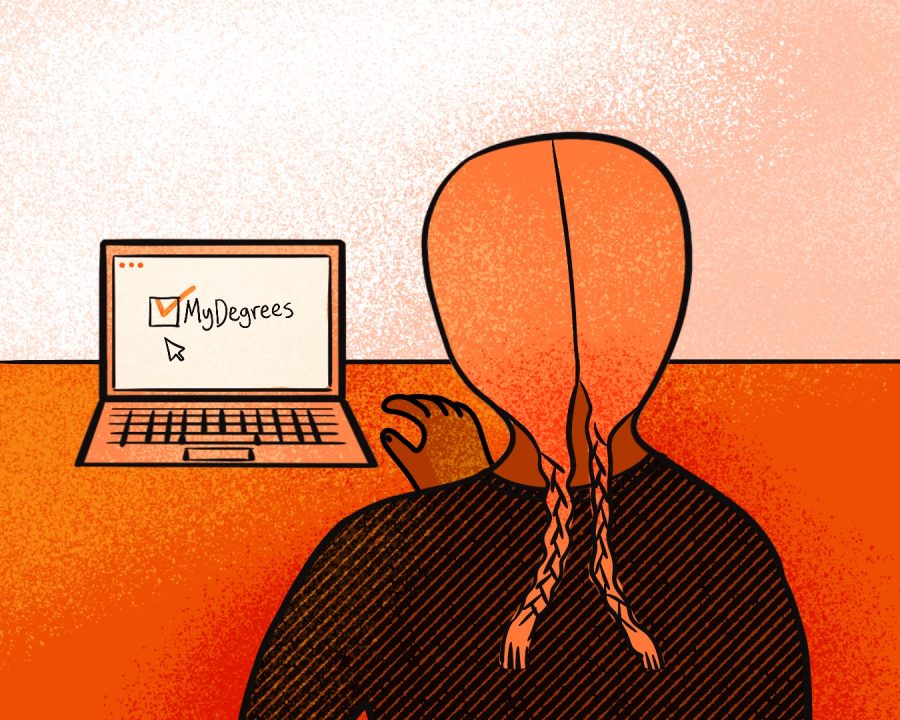Change in Baccalaureate Core to Start Summer 2025
A college student looks at their OSU student portal ahead of impending changes.
December 14, 2022
Oregon State University’s Baccalaureate Core curriculum has been the same since 1991, and now these requirements are set to change.
Changes in OSU’s Bacc Core requirements, renamed general education requirements, were approved by the Faculty Senate in October 2022, and will go live starting in the summer term of 2025.
Baccalaureate Core Director Mckenzie Huber states that the changes in general education are meant to cater towards the changing demographic on campus, free up space for other classes and promote success beyond the classroom.
According to Huber, the new general education curriculum will be 42 to 48 credits, depending on whether students choose a three credit or four credit class in a couple categories. The updated gen-ed will include classes not yet seen at OSU, while also retaining other requirements in the Bacc Core.
“Students who join (OSU) prior to (the change) can always move into that curriculum if it makes sense to them and their degree progression,” Huber said.
The curriculum will include classes not yet seen at OSU: a “Transitions” class, a zero credit “Beyond OSU Career Integration” requirement and a “Seeking Solutions” class.
The transitions class is two credits, and is designed to promote wellness practices and help students think about their holistic needs when they first arrive at OSU, whether that be on-campus or over Ecampus, Huber said.
“[Transitions classes] are meant for students to kind of build community,” Huber said.” To help set goals and figure out how to navigate this place.”
The beyond OSU career integration requirement is to get students involved in career opportunities early.
“You probably look at your syllabus and say: ‘Huh, this is an academic learning outcome, what job skills or requirements does this meet?’” Huber said. “We really want to help students translate this academic piece they’re getting into life beyond OSU.”
Huber said that the requirement can be met in many ways, such as going to a career fair, working on your resume with someone from the Career Development Center, doing research in a lab or going to a symposium.
According to Huber, seeking solutions is meant to take students from different majors and pose them with a problem they must work together to address.
“Maybe we’ll take a creative writer, an engineer, a student from natural resources, a sociology major, and you all sign up to do a global food poverty course…bringing your curricular expertise to that and working in a group,” Huber said. “So that’s what we are preparing you for when you leave OSU to work in interdisciplinary team settings.”
The current general education requirement “Difference, Power & Discrimination” is set to be renamed “Difference, Power, and Oppression,” and students under the new curriculum will take two of these classes, one as a foundation, and an advanced DPO class that refers back to one’s specific major.
Transfer students who have already completed the Core Transfer Map or Associates of Arts Oregon Transfer Degree at a community college will be able to use these degrees to fulfill the entire foundational core in general education, which is about 31 to 35 of the general education requirements, Huber said.
This is one way that the curriculum is tailored to help ease transition into the university system, and promote an ever-growing demographic of students at OSU.
“We used to be just 9% transfer students, and now we’re 40% transfer students,” Huber said.
Also, Huber said that the current general education received by students does not reflect the current status of OSU.
“We needed to make this change to accommodate our changing students and their demographics,” Huber said. “When this curriculum was created we didn’t have [OSU] Cascades and we didn’t have Ecampus.”
Along with the University of Oregon and other universities in the state, OSU is a member of the American Association of Colleges and Universities, a national organization to further diversity, equity and inclusion in higher education. Huber says it’s about time OSU’s general education supports and reflects this mission’s goals.
“This is going to be a new shift in how we think about general education,” Huber said. “We are really trying to rethink the value and purpose of it, and make sure that it is meaningful, useful and supports our students and inclusive excellence here at OSU.”



















































































![Newspaper clipping from February 25, 1970 in the Daily Barometer showing an article written by Bob Allen, past Barometer Editor. This article was written to spotlight both the student body’s lack of participation with student government at the time in conjunction with their class representatives response. [It’s important to note ASOSU was not structured identically to today’s standards, likely having a president on behalf of each class work together as one entity as opposed to one president representing all classes.]](https://dailybaro.orangemedianetwork.com/wp-content/uploads/2025/03/Screenshot-2025-03-12-1.00.42-PM-e1741811160853.png)























